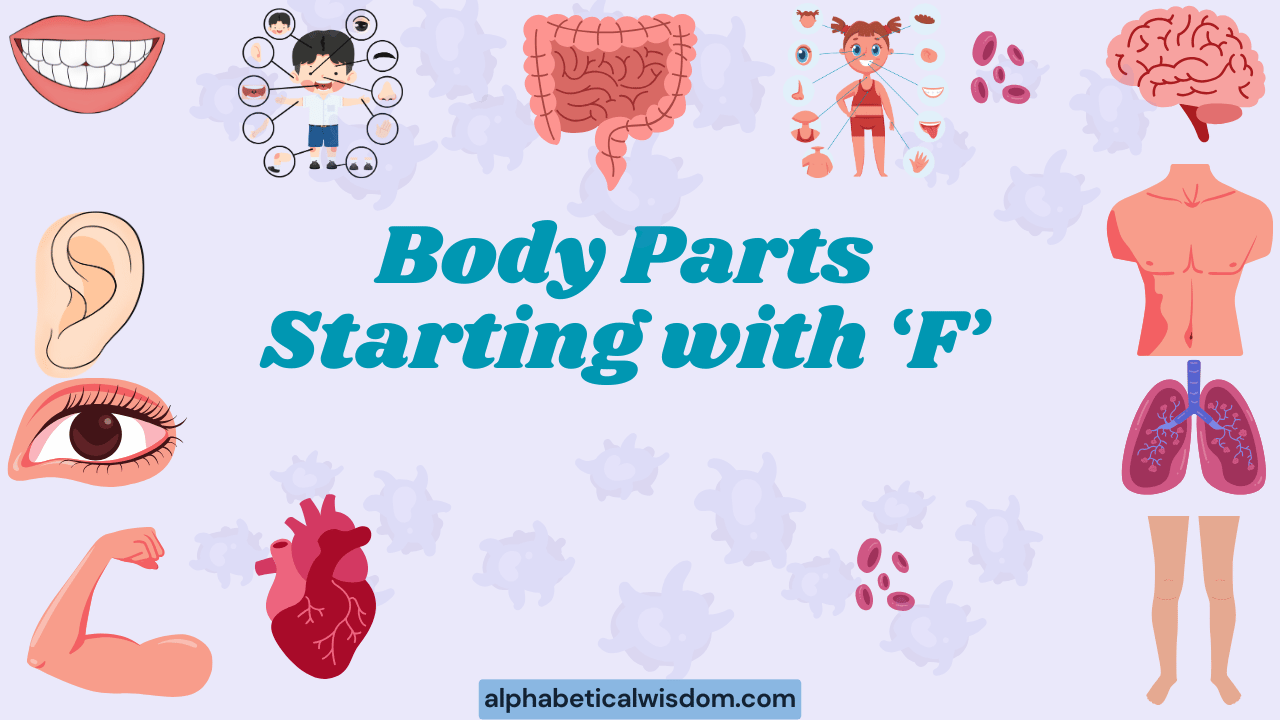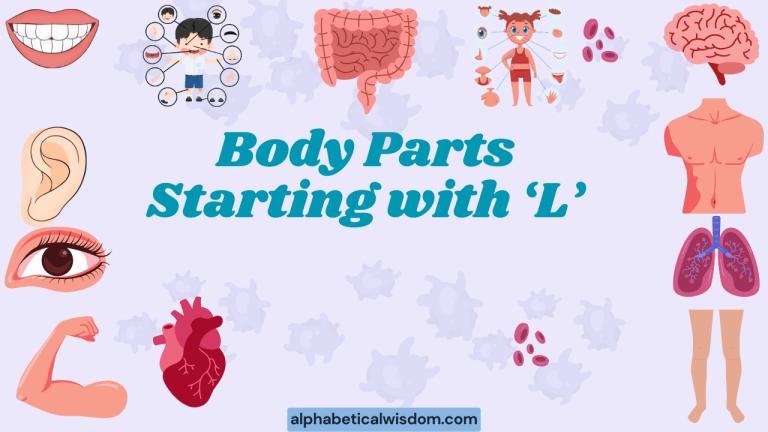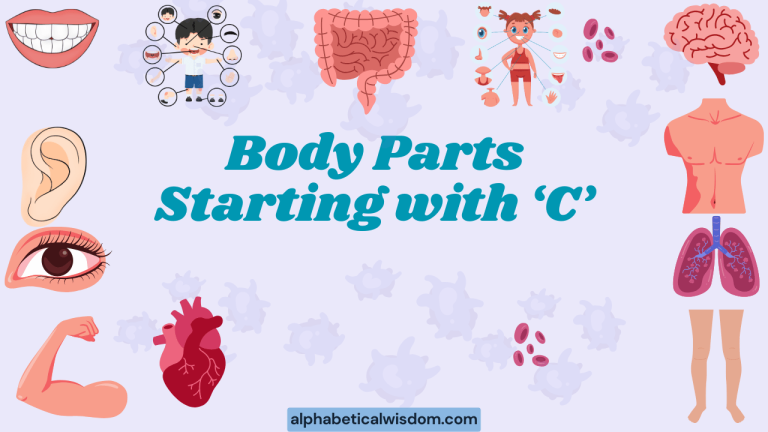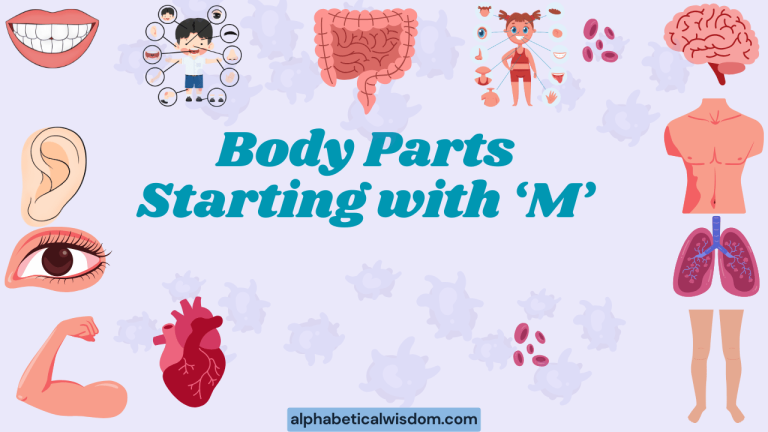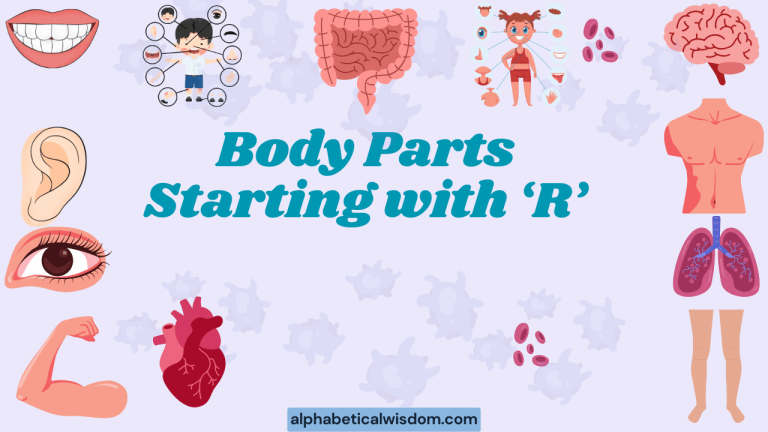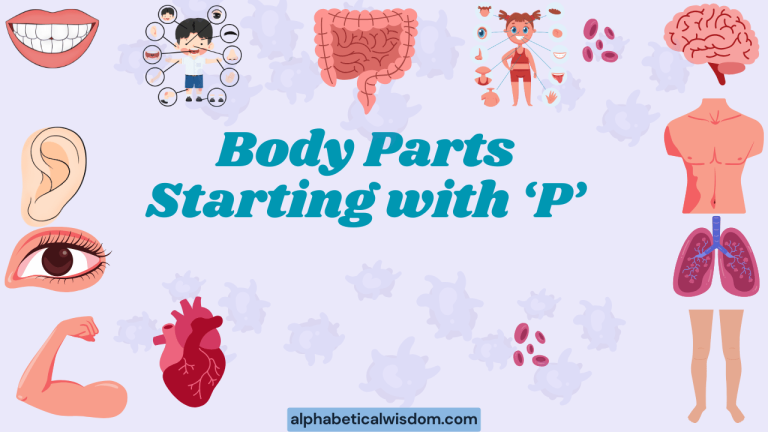Body Parts Starting with F: A Comprehensive Grammar Guide
Understanding the vocabulary related to body parts is crucial for effective communication, particularly in fields like medicine, fitness, and general health. Focusing on body parts that start with the letter “F” not only expands your vocabulary but also enhances your ability to describe physical attributes and conditions accurately.
This guide is designed to help English language learners, medical professionals, and anyone interested in improving their anatomical vocabulary. By mastering these terms, you can communicate more precisely and confidently in various contexts.
Table of Contents
- Introduction
- Definition of Body Parts Starting with F
- Structural Breakdown
- Types and Categories
- Examples
- Usage Rules
- Common Mistakes
- Practice Exercises
- Advanced Topics
- FAQ
- Conclusion
Definition of Body Parts Starting with F
Body parts starting with the letter “F” include several important anatomical terms, each with specific functions and locations. These terms are essential for describing physical characteristics, medical conditions, and overall health.
Understanding these terms allows for more precise and effective communication in various contexts, from everyday conversations to professional medical settings.
Face: The front part of the head, from the forehead to the chin, including the eyes, nose, mouth, and cheeks. The face is crucial for expressing emotions and is a primary identifier of individuals.
Fingers: The digits of the hand, typically five in number, used for grasping, manipulating objects, and tactile sensation. Each finger consists of several bones (phalanges) and is essential for fine motor skills.
Feet: The plural of foot, which is the terminal part of the leg, used for standing, walking, and running. The foot consists of numerous bones, muscles, and ligaments that provide support and mobility.
Fist: A hand with the fingers and thumb tightly closed. A fist is often made in anger or for striking.
Forehead: The part of the face above the eyes and below the hairline. The forehead is a prominent feature of the face and can be used to express emotions or identify individuals.
Forearm: The part of the arm between the elbow and the wrist. The forearm contains two bones (radius and ulna) and numerous muscles that control hand and wrist movement.
Structural Breakdown
Each body part starting with “F” has a distinct structural composition and plays a specific role in the human body. Understanding the structural elements helps in comprehending their function and potential issues.
Face: The face is composed of skin, muscles, bones (including the skull and facial bones), nerves, and blood vessels. Facial muscles are responsible for expressions, while the underlying bones provide structure and support. The sensory organs (eyes, nose, and mouth) are also integral parts of the face.
Fingers: Each finger contains three phalanges (except the thumb, which has two), along with tendons, ligaments, nerves, and blood vessels. The phalanges are connected by joints, allowing for flexibility and movement. The fingertips are highly sensitive due to a high concentration of nerve endings.
Feet: The foot is a complex structure consisting of 26 bones, numerous muscles, ligaments, and tendons. The bones are divided into three sections: the tarsals, metatarsals, and phalanges. The arches of the foot provide support and shock absorption during movement.
Fist: Structurally, a fist involves the clenching of the fingers tightly into the palm, with the thumb usually wrapped around the fingers for added support and force. The muscles of the hand and forearm work together to form and maintain the fist.
Forehead: The forehead is primarily composed of the frontal bone of the skull, covered by skin and a layer of subcutaneous tissue. Muscles in the forehead allow for raising the eyebrows and creating facial expressions.
Forearm: The forearm contains the radius and ulna bones, which run parallel to each other. Muscles in the forearm control the movement of the wrist, hand, and fingers. The radius allows the forearm to rotate, enabling pronation and supination.
Types and Categories
Face
The face can be categorized based on various features, including shape, symmetry, and specific characteristics. Facial features are often described in terms of their prominence and proportion.
Face Shapes: Common face shapes include oval, round, square, heart-shaped, and oblong. Each shape is defined by the proportions and contours of the facial features.
Facial Features: Specific features such as the eyes, nose, mouth, and cheeks can be categorized based on their size, shape, and position. For example, eyes can be described as large, small, almond-shaped, or round.
Fingers
Fingers are categorized by their position on the hand and their specific functions. Each finger has a unique name and contributes to overall hand dexterity.
Finger Names: The fingers are typically referred to as the thumb, index finger, middle finger, ring finger, and little finger (or pinky).
Finger Movements: Fingers can perform various movements, including flexion, extension, abduction, and adduction. These movements are essential for grasping, manipulating objects, and performing fine motor tasks.
Feet
Feet are categorized based on their arch type and the presence of any deformities. Understanding these categories is important for diagnosing and treating foot-related conditions.
Arch Types: Foot arches can be classified as high, medium, or flat. The arch provides support and shock absorption during walking and running.
Foot Deformities: Common foot deformities include bunions, hammertoes, and plantar fasciitis. These conditions can cause pain and affect mobility.
Fist
The fist is categorized primarily based on its purpose and the context in which it is formed. It can be a gesture of aggression, solidarity, or excitement.
Aggressive Fist: Used in combat or as a threat, indicating a readiness to fight.
Solidarity Fist: Raised in the air as a symbol of unity, resistance, or support for a cause.
Excitement Fist: Clenched tightly as an expression of joy, triumph, or intense emotion.
Forehead
The forehead’s categorization is often based on its size, shape, and the presence of wrinkles or other distinguishing features. These characteristics can influence perceived age and expressions.
Size and Shape: Foreheads can be described as high, low, wide, narrow, sloping, or prominent, influencing facial aesthetics.
Wrinkles and Lines: The presence of wrinkles, frown lines, or expression lines on the forehead can indicate age, emotional state, or habitual facial expressions.
Forearm
The forearm is categorized based on its position (pronation or supination) and the muscles that control its movement. These categories are important for understanding forearm function and potential injuries.
Pronation: The rotation of the forearm so that the palm faces downward or backward.
Supination: The rotation of the forearm so that the palm faces upward or forward.
Examples
The following examples illustrate the use of body parts starting with “F” in various contexts.
Face Examples
The face is a central point of identification and expression. Here are some examples of how “face” is used in sentences.
The following table shows sentences using “face” in different contexts.
| Sentence | Context |
|---|---|
| Her face lit up when she saw the surprise gift. | Expression |
| The doctor examined the patient’s face for signs of illness. | Medical |
| He recognized her face in the crowd. | Identification |
| She washed her face with soap and water. | Hygiene |
| The actor’s face was covered in makeup. | Performance |
| His face was flushed with embarrassment. | Emotion |
| The wind whipped at her face as she walked. | Environment |
| She applied sunscreen to her face to protect it from the sun. | Protection |
| He has a kind face. | Description |
| The photograph showed his smiling face. | Visual |
| She frowned, a crease forming on her face. | Expression |
| He turned his face away to hide his tears. | Emotion |
| The mask covered most of her face. | Protection/Disguise |
| She has a beautiful face. | Description |
| He punched him in the face. | Action |
| She put on her poker face. | Expression |
| The dog licked her face. | Action |
| His face was covered in dirt. | Description |
| She painted her face for Halloween. | Activity |
| The baby has a cute face. | Description |
| His face was serious. | Expression |
| She stared him in the face. | Action |
| He has a baby face. | Description |
| Her face was pale. | Description |
| He slapped him across the face. | Action |
Fingers Examples
Fingers are essential for dexterity and interaction with the world. Here are some examples of how “fingers” is used in sentences.
The following table shows sentences using “fingers” in different contexts.
| Sentence | Context |
|---|---|
| She snapped her fingers to get his attention. | Action |
| He counted on his fingers. | Calculation |
| Her fingers were nimble as she knitted. | Skill |
| He burned his fingers on the hot stove. | Accident |
| She wore a ring on her finger. | Adornment |
| His fingers trembled with nervousness. | Emotion |
| She pointed her finger at the suspect. | Identification |
| The pianist’s fingers flew across the keys. | Skill |
| He pricked his finger with a needle. | Accident |
| She wrapped a bandage around her injured finger. | First Aid |
| He wiggled his fingers. | Action |
| She crossed her fingers for good luck. | Superstition |
| He had ink on his fingers. | Description |
| She bit her fingernails. | Habit |
| He tapped his fingers impatiently. | Emotion |
| She had long, slender fingers. | Description |
| He couldn’t feel his fingers in the cold. | Sensation |
| She massaged her fingers. | Action |
| He had a cut on his finger. | Injury |
| She painted her fingernails red. | Adornment |
| He lost a finger in the accident. | Injury |
| She flexed her fingers. | Action |
| He had arthritis in his fingers. | Medical Condition |
| She drummed her fingers on the table. | Action |
| He snapped his fingers to the beat. | Action |
Feet Examples
Feet are vital for mobility and support. Here are some examples of how “feet” is used in sentences.
The following table shows sentences using “feet” in different contexts.
| Sentence | Context |
|---|---|
| She walked barefoot on the beach. | Action |
| His feet hurt after standing all day. | Sensation |
| She wore sandals on her feet. | Clothing |
| He stomped his feet in anger. | Emotion |
| The dancer moved her feet gracefully. | Skill |
| He had blisters on his feet. | Condition |
| She soaked her feet in warm water. | Relaxation |
| He kicked the ball with his feet. | Action |
| She measured her feet for new shoes. | Shopping |
| His feet were cold in the winter. | Sensation |
| She had small feet. | Description |
| He shuffled his feet nervously. | Emotion |
| She had calluses on her feet. | Condition |
| He washed his feet in the river. | Hygiene |
| She painted her toenails. | Adornment |
| He stubbed his toe. | Accident |
| She had flat feet. | Condition |
| He had athlete’s foot. | Medical Condition |
| She massaged her feet. | Action |
| He had socks on his feet. | Clothing |
| She danced on her feet. | Action |
| He stood on his feet. | Action |
| She tripped over her own feet. | Accident |
| He had big feet. | Description |
| She pampered her feet at the spa. | Relaxation |
Fist Examples
A fist can represent various emotions and actions, from anger to solidarity. Here are some examples of its usage.
The following table shows sentences using “fist” in different contexts.
| Sentence | Context |
|---|---|
| He clenched his fist in anger. | Emotion |
| She raised her fist in protest. | Activism |
| He slammed his fist on the table. | Emotion |
| The boxer made a fist, ready to fight. | Sports |
| He shook his fist at the driver who cut him off. | Emotion |
| She pounded her fist against the door. | Action |
| He made a fist and punched the wall. | Emotion/Action |
| The crowd raised their fists in solidarity. | Activism |
| He held his fist tightly. | Tension |
| She shook her fist in frustration. | Emotion |
| He slammed his fist down. | Emotion |
| She made a fist and hit him. | Action |
| He clenched his fist tightly. | Emotion |
| She shook her fist angrily. | Emotion |
| He pounded his fist on the podium. | Action |
| She raised her fist triumphantly. | Emotion |
| He clenched his fist defensively. | Emotion |
| She shook her fist in defiance. | Emotion |
| He slammed his fist on the desk. | Emotion |
| She raised her fist in support. | Activism |
Forehead Examples
The forehead is a prominent facial feature often associated with expressions and age. Here are some examples of its usage.
The following table shows sentences using “forehead” in different contexts.
| Sentence | Context |
|---|---|
| She wiped the sweat from her forehead. | Action |
| He kissed her on the forehead. | Affection |
| She frowned, creasing her forehead. | Emotion |
| He had a scar on his forehead. | Description |
| She rested her hand on her forehead, feeling ill. | Sensation |
| The sun beat down on his forehead. | Environment |
| She furrowed her forehead in concentration. | Emotion |
| He had a high forehead. | Description |
| She applied makeup to her forehead. | Adornment |
| He felt a throbbing pain in his forehead. | Sensation |
| She smoothed her forehead. | Action |
| He touched his forehead thoughtfully. | Action |
| She had wrinkles on her forehead. | Description |
| He cooled his forehead with a cloth. | Action |
| She raised her eyebrows, wrinkling her forehead. | Emotion |
| He bumped his forehead. | Accident |
| She massaged her forehead. | Action |
| He had a fever, and his forehead was hot. | Medical Condition |
| She looked thoughtful, with her hand on her forehead. | Emotion |
| He had a birthmark on his forehead. | Description |
Forearm Examples
The forearm is crucial for movement and strength in the arm. Here are some examples of its usage.
The following table shows sentences using “forearm” in different contexts.
| Sentence | Context |
|---|---|
| He flexed his forearm muscles. | Action |
| She rested her forearm on the table. | Action |
| He had a tattoo on his forearm. | Adornment |
| She felt a sharp pain in her forearm. | Sensation |
| He rolled up his sleeves to expose his forearms. | Action |
| The weightlifter strained his forearm during the lift. | Sports |
| She had a bruise on her forearm. | Injury |
| He scratched his forearm absentmindedly. | Action |
| She had strong forearms from years of rowing. | Description |
| He bandaged his forearm after the injury. | First Aid |
| She showed her forearm. | Action |
| He injured his forearm. | Injury |
| She strengthened her forearm. | Action |
| He had hair on his forearm. | Description |
| She had a rash on her forearm. | Medical Condition |
| He twisted his forearm. | Injury |
| She massaged her forearm. | Action |
| He had a burn on his forearm. | Injury |
| She flexed her forearm muscles. | Action |
| He rested his forearm. | Action |
Usage Rules
Using body part vocabulary correctly involves understanding the grammatical context and the specific meanings of each term.
Singular vs. Plural: Most body parts have both singular and plural forms. For example, “face” is singular, while “faces” is plural. “Foot” is singular, while “feet” is plural (an irregular plural form).
Possessive Forms: To show possession, use the possessive form (‘s). For example, “the doctor’s face” or “her fingers’ length.”
Adjectives: Adjectives are used to describe body parts. For example, “a round face,” “long fingers,” or “flat feet.”
Verbs: Verbs are used to describe actions involving body parts. For example, “She washed her face,” “He wiggled his fingers,” or “She walked on her feet.”
Common Mistakes
Here are some common mistakes when using body part vocabulary and how to correct them.
Incorrect: “I hurt my foots.”
Correct: “I hurt my feet.”
Incorrect: “She has a long finger.”
Correct: “She has long fingers.”
Incorrect: “He washed his faces.”
Correct: “He washed his face.”
Incorrect: “The doctor examined the patient face.”
Correct: “The doctor examined the patient’s face.”
Incorrect: “She has pain in her forearm.”
Correct: “She has pain in her forearm.” (This is technically correct, but more natural would be “She has pain in her forearm.”)
Practice Exercises
Test your understanding with these practice exercises.
Exercise 1: Fill in the Blanks
Complete the following sentences with the correct body part starting with “F.”
| Question | Answer |
|---|---|
| 1. She wiped the sweat from her __________. | forehead |
| 2. He wiggled his __________ to show he was cold. | fingers |
| 3. She walked barefoot on the __________. | feet |
| 4. He clenched his __________ in anger. | fist |
| 5. The doctor examined the patient’s __________. | face |
| 6. The tattoo was on his __________. | forearm |
| 7. She painted her __________ for the party. | face |
| 8. He counted on his __________. | fingers |
| 9. She massaged her tired __________. | feet |
| 10. He raised his __________ in protest. | fist |
Exercise 2: Correct the Mistakes
Identify and correct the mistakes in the following sentences.
| Question | Answer |
|---|---|
| 1. I hurt my foots. | I hurt my feet. |
| 2. She has a long finger. | She has long fingers. |
| 3. He washed his faces. | He washed his face. |
| 4. The doctor examined the patient face. | The doctor examined the patient’s face. |
| 5. She has pain in her forearm. | She has pain in her forearm. |
| 6. He broke his finger’s. | He broke his finger. |
| 7. She has beautiful face. | She has a beautiful face. |
| 8. He kicked with his foots. | He kicked with his feet. |
| 9. She injured her forearms. | She injured her forearm. |
| 10. He wiped his foreheads. | He wiped his forehead. |
Exercise 3: Sentence Construction
Create sentences using the following body parts starting with “F.”
| Word | Example Sentence |
|---|---|
| Face | Her face was radiant with happiness. |
| Fingers | His fingers were stained with ink. |
| Feet | The cold water numbed her feet. |
| Fist | He pounded his fist on the table to emphasize his point. |
| Forehead | She wrinkled her forehead in confusion. |
| Forearm | The doctor checked his forearm for a reaction to the injection. |
| Fingerprint | The detective examined the glass for fingerprints. |
| Fingernail | She painted her fingernails a vibrant shade of red. |
| Footprint | The footprints in the snow led away from the house. |
| Forefinger | He pointed his forefinger accusingly at the suspect. |
Advanced Topics
For advanced learners, explore the nuances of anatomical terminology and specialized contexts.
Medical Terminology: Understanding medical terms related to body parts, such as “facial nerve,” “phalangeal fractures,” or “plantar fasciitis,” is essential for healthcare professionals.
Idiomatic Expressions: Many idioms use body part vocabulary. For example, “to save face” means to avoid embarrassment, and “to put your best foot forward” means to make a good impression.
Anatomical Variations: Human anatomy can vary significantly. Understanding these variations is important for accurate diagnosis and treatment in medical settings.
FAQ
Here are some frequently asked questions about body parts starting with “F.”
Q1: What is the difference between “foot” and “feet”?
A: “Foot” is the singular form, referring to one foot, while “feet” is the plural form, referring to two or more feet. This is an example of an irregular plural in English.
Q2: How do I use “face” in a possessive sentence?
A: To show possession, use the possessive form (‘s). For example, “the doctor’s face” or “her face’s expression.”
Q3: What are the names of the fingers?
A: The fingers are typically referred to as the thumb, index finger, middle finger, ring finger, and little finger (or pinky).
Q4: What is the function of the arches in the feet?
A: The arches of the foot provide support and shock absorption during walking and running. They help distribute weight evenly and reduce stress on the bones and joints.
Q5: How can I improve my vocabulary of body parts?
A: Use flashcards, read medical articles, watch documentaries, and practice using the terms in conversation. Consistent exposure and active use are key to expanding your vocabulary.
Q6: What is the anatomical term for the bones in the fingers?
A: The bones in the fingers are called phalanges. Each finger (except the thumb) has three phalanges: the proximal, middle, and distal phalanges. The thumb has only two: the proximal and distal phalanges.
Q7: What are some common injuries related to the forearm?
A: Common forearm injuries include fractures (breaks in the radius or ulna), sprains (ligament injuries), strains (muscle or tendon injuries), and nerve compressions, such as carpal tunnel syndrome.
Q8: What does it mean when someone says they are “putting their best foot forward”?
A: This idiom means that someone is trying to make a good impression or present themselves in the best possible light. It suggests making a positive start or effort in a new situation.
Q9: What is the difference between a sprain and a strain in relation to body parts like the forearm?
A: A sprain involves stretching or tearing of ligaments, which connect bones at a joint. A strain, on the other hand, involves stretching or tearing of muscles or tendons, which connect muscles to bones. Both can occur in the forearm due to overuse or injury.
Q10: How does the position of the forearm (pronation vs. supination) affect hand movements?
A: Pronation (palm facing down) and supination (palm facing up) are crucial for hand and wrist movements. Supination allows you to hold a bowl of soup, while pronation is used for typing on a keyboard. These movements increase the versatility and range of motion of the hand.
Conclusion
Mastering body part vocabulary, especially those starting with “F,” is essential for clear and accurate communication. Understanding the definitions, structural elements, and usage rules of these terms enhances your ability to describe physical attributes, medical conditions, and everyday actions.
By practicing regularly and addressing common mistakes, you can confidently incorporate these terms into your English vocabulary.
Remember to use these terms in context, pay attention to singular and plural forms, and practice with exercises to reinforce your understanding. With consistent effort, you’
ll be well-equipped to communicate effectively about body parts and related topics.
